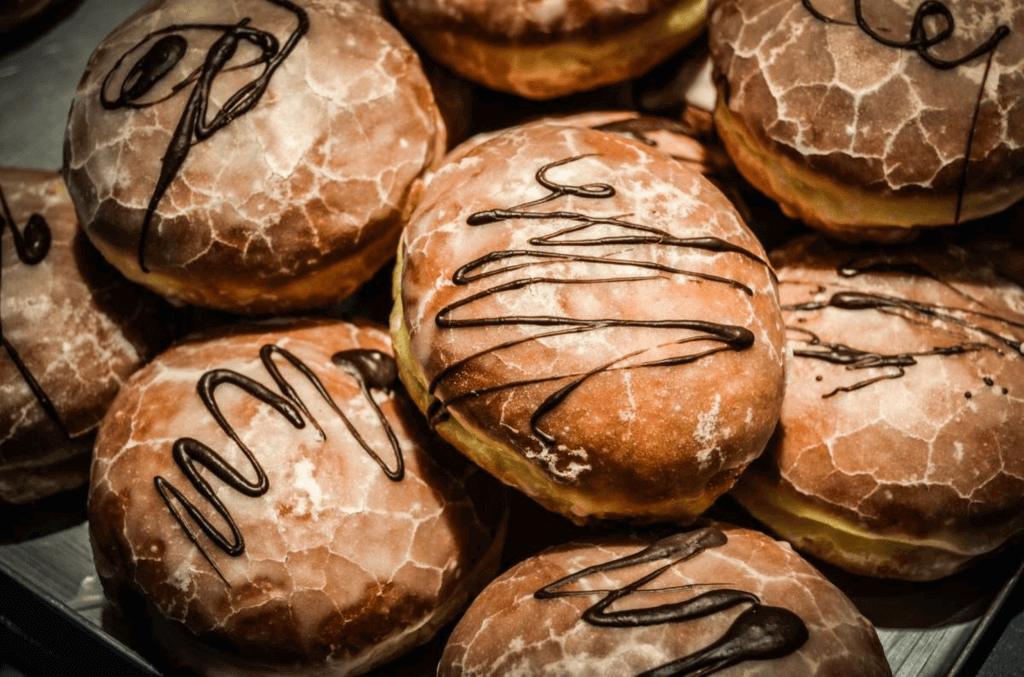Fat Thursday
(Also known as Giovedí Grasso)
Fat Thursday is observed next on Thursday, February 12th, 2026 (23 days from today).

When you are sad, tired, depressed, stressed, eating some sweets can help you become excited, refreshed, but if you are "addicted" to sweets, which is not good at all. However, Poland traditionally has a day to celebrate all flour-related dishes. Fat Thursday is celebrated every year on February 19, or the Thursday of the week before the Vegetarian Festival.
Fat Thursday provides a great opportunity to eat pastries without feeling guilty. Especially the donuts and the Paczki. Paczki, pronounced the key PUNCH, are donuts filled with quartz, traditionally served in the weeks leading up to Lent. In Northeast Ohio, these delicious confections can be found in Slavic Village bakeries and other Eastern European grocers during the pre-Lent season (mid-January to mid-March).
The tradition of serving Paczki before Lent originated in Poland in the Middle Ages, during the reign of August III, who invited French chefs to work at his castle.
Paczki day precedes the start of Lent, and the traditional baking of Paczki is a way to use up all the fats, sugars, and fruits in the house - things that are forbidden during the strict Polish Lent.
In Poland, Paczki Day, or Fat Thursday, the day on which all the last Paczki are consumed, is the Thursday before Ash's Wednesday. In Cleveland and the rest of the Midwest, Paczki Day is celebrated on Mardi gras, the day before Ash Wednesday.
Observing Fat Thursday
On Fat Thursday, you can eat sweets freely without fear of being bothered. Or you can also make your own Paczki at home although it is not easy. Try following the recipe below:
Resources:
- About 450g all-purpose flour bột
- About 250ml of fresh milk without sugar
- 2 egg yolks
- About 60g of unsalted butter, melted and cooled
- About 50g of white granulated sugar
- About 7g dry yeast, 2g salt
- About 2ml vanilla essence
- Powdered sugar
- Fruit jam or custard cream (used for filling)
Making:
1. Heat 1/2 of the fresh milk, so that the milk is at an average temperature of about 35 - 40 degrees Celsius (not hotter, it will kill the yeast or weaken its activity). Add 5 grams of sugar and all this yeast into the milk, stir with wooden chopsticks. After about 5-10 minutes, you will see the glaze forming a patch, a bit like crab bricks. If the yeast does not bloom, there are about two possibilities, either the yeast has a problem, or the milk is too hot to kill the yeast, so throw it away and prepare to start over.
2. Sift flour, sugar, salt & milk (if available) into a bowl. Mixer. Put the remaining ingredients including butter, eggs, yeasted milk and 1/2 of the remaining milk in a bowl. Use the merge wood to when the merge into a block. Get up a sun towel, let it rest for 8-10 minutes. Fing to this rest will help for the new. More caution and ease in the case of hand kneading. If potement by machine, can not to do this step.
3. Pour the dough onto a table covered with a thin layer of flour, if the dough is too wet and sticky (maybe because the flour is poorly absorbent), you can use a little more flour during the kneading process dry flour) to spread evenly over the countertop and rub hands to make kneading easier. However, try to use as little powder as possible. If kneading by hand, it will usually take about 15-20 minutes. After the dough is kneaded, it will be flexible and elastic. If you press your finger on the surface of the dough, it will swell again.
4. Put the dough into a bowl that has been coated with a very thin layer of cooking oil. Turn the dough over so that the cooking oil is evenly coated on the outside of the dough (to prevent the dough from drying out quickly during the incubation process. Cover the bowl with plastic wrap (or cover the bowl with a damp cloth), incubate the dough at a temperature of 30-38 degrees C until the dough has doubled in size. To check if the dough has risen, gently press one or two fingers into the dough, about 1-2cm deep. After pulling your hand up, if the indentation remains, it means the dough has matured.
5. After the dough has cooled enough, press or lightly punch with the back of your hand to deflate the air bubbles in the dough. Remove the dough from the bowl, knead again briefly for about 1-2 minutes. Coat a little dry flour on the tabletop and rolling pin, roll the dough into a piece about 0.7 - 1 cm thick. Cover the dough with plastic or a damp cloth, let the dough rest for about 5-7 minutes (to prevent the cake from shrinking after cutting). Cut the dough into a round doughnut shape.
6. Second incubation: Wrap the whole tray of dough and then incubate at room temperature, if it is hot. Or turn on the oven about 50 degrees Celsius for 5 minutes and then turn off the oven, put the dough tray in the oven, add a cup of boiling water (to keep it moist), incubate the cake at a temperature of 35-40 degrees Celsius until the cake expands about 80 %.
7. Fry the cake: Prepare a small pot, pour a lot of oil. Heat the oil to about 150 - 170 degrees Celsius, then drop the cakes in and fry until golden on one side, flip and fry the other side until golden. Remove the cake to a plate lined with absorbent paper to absorb excess grease.
Share your Fat Thursday with everyone with the hashtag #FatThursday.
Observed
Fat Thursday has been observed 52 days before Easter.Dates
Thursday, February 8th, 2024
Thursday, February 27th, 2025
Thursday, February 12th, 2026
Thursday, February 4th, 2027
Thursday, February 24th, 2028


